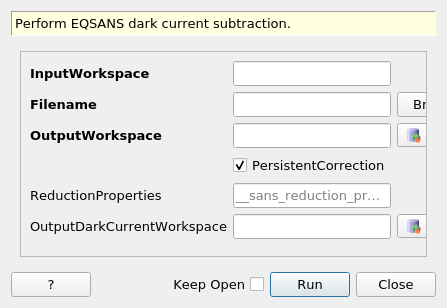\(\renewcommand\AA{\unicode{x212B}}\)
EQSANSDarkCurrentSubtraction v2¶

EQSANSDarkCurrentSubtraction dialog.¶
Summary¶
Perform EQSANS dark current subtraction.
Properties¶
Name |
Direction |
Type |
Default |
Description |
|---|---|---|---|---|
InputWorkspace |
Input |
Mandatory |
||
Filename |
Input |
string |
Mandatory |
The name of the input event Nexus file to load as dark current. Allowed extensions: [‘_event.nxs’] |
OutputWorkspace |
Output |
Mandatory |
||
PersistentCorrection |
Input |
boolean |
True |
If true, the algorithm will be persistent and re-used when other data sets are processed |
ReductionProperties |
Input |
string |
__sans_reduction_properties |
|
OutputDarkCurrentWorkspace |
Output |
|||
OutputMessage |
Output |
string |
Description¶
Subtract the dark current from an EQSANS data set. This algorithm is rarely called directly. It is called by SANSReduction.
This workflow algorithm will:
Properly load the dark current data set
Normalize the dark current to the data taking period
Subtract the dark current from the input workspace
The dark current is subtracted pixel by pixel by normalizing the dark current data by counting time. The total number of dark current counts \(N_{dc}(i)\) for each pixel i is obtained by integrating over all time of flight bins. For a given pixel and wavelength bin, the corrected signal is given by:
\(I'(i,\lambda_j)=I_{data}(i,\lambda_j)-N_{dc}(i) \ \ \frac{T_{data}}{T_{dc}} \ \ \frac{t_{frame}-t^{low}_{cut} - t^{high}_{cut}}{t_{frame}} \ \ \frac{\Delta\lambda_j}{\lambda_{max}-\lambda_{min}}\)
where the T-values are the counting times for the data set and the dark current (dc). The \(t_{cut}\) values are the TOF cuts at the beginning and end of a frame. \(t_{frame}\) is the width of a frame. \(\Delta\lambda_j\) is the width of the wavelength bin we are considering.
Categories: AlgorithmIndex | Workflow\SANS\UsesPropertyManager
Source¶
C++ header: EQSANSDarkCurrentSubtraction2.h
C++ source: EQSANSDarkCurrentSubtraction2.cpp
